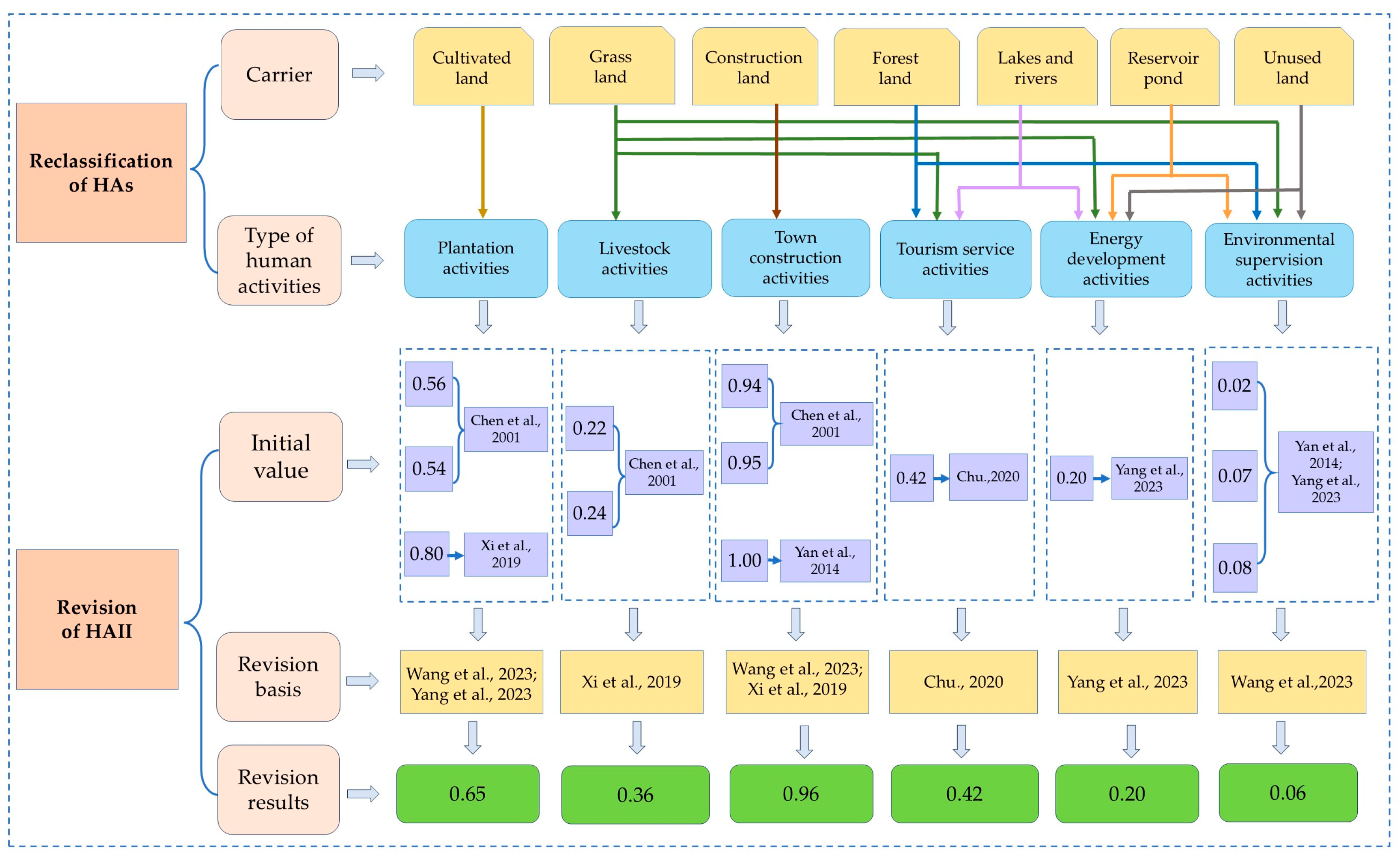Response of Ecosystem Services to Human Activities in Gonghe Basin of the Qinghai–Tibetan Plateau
Abstract
1. Introduction
2. Materials and Methods
2.1. Study Area
2.2. Data Sources and Preprocessing
2.3. Methodology
2.3.1. Human Activity Intensity Index
2.3.2. Assess Ecosystem Services
- (1)
- Water yield service (WY)
- (2)
- Soil conservation service (SC)
- (3)
- Carbon sequestration service (CS)
- (4)
- Habitat quality assessment (HQ)
- (5)
- Integrated ecosystem service capability
2.3.3. Response Relationship Evaluation
- (1)
- Spatial correlation analysis
- (2)
- Bivariate spatial autocorrelation analysis
3. Results
3.1. Analysis of Temporal and Spatial Evolution of HAI
3.2. Characterization of Spatial and Temporal Changes in ESs
3.2.1. Water Yield Service (WY)
3.2.2. Soil Conservation Service (SC)
3.2.3. Carbon Sequestration Service (CS)
3.2.4. Habitat Quality (HQ)
3.2.5. Ecosystem Services (ESs)
3.3. Analysis of Response Relationships
3.3.1. Correlation Analysis Between HAs and Various ESs
3.3.2. Bivariate Spatial Autocorrelation Analysis of HAs and ESs
4. Discussion
4.1. Reconstruction of HA Types and Intensity
4.2. Analysis of ES Correlations and Influencing Factors
4.3. Regional Management Recommendations Based on Response Relationships
4.4. Limitations
5. Conclusions
- (1)
- From 2000 to 2020, the HAI in the Gonghe Basin was mainly low-intensity, but the scope of activities continued to expand. Among them, the area of plantation activities and town construction activities of medium and high intensity increased significantly and showed a trend of spreading along the northwest-southeast axis. Tourism service activities and energy development activities of medium intensity showed local growth characteristics, while environmental supervision activities showed low intensity and wide distribution patterns.
- (2)
- From 2000 to 2020, the four typical ESs in the Gonghe Basin presented diverse characteristics but were also interrelated. The spatial distribution of WY and SC services exhibited of high in the east and south and diminished levels in the northwest. CS services showed a pattern of high in the south, low in the central and western regions and scattered distribution. HQ showed a distribution pattern of high in the northeast and south and low in the middle. In terms of time change, WY service showed a trend of decreasing first and then increasing, while the SC service showed the opposite trend. CS services exhibited consistent growth service generally showed an increasing trend, and HQ showed a trend of increasing first and then decreasing slowly. In general, the spatial distribution of ESs showed a pattern of high in the southeast and low in the northwest, and CS was the dominant service function of ESs in the Gonghe Basin.
- (3)
- HAs were negatively correlated with ESs in the Gonghe Basin and showed a trade-off relationship, with the correlation showing a trend of initially increasing and then decreasing. Primary spatial association patterns between HAs and ESs predominantly exhibited L-H and H-L clustering configurations. L-H aggregation was mainly distributed in areas dominated by grassland and unused land. H-L aggregation was mainly distributed in areas dominated by cultivated land, construction land, and forest. HAs were also negatively correlated with individual ESs. In terms of spatial aggregation, HAs and WY were mainly L-H aggregation, HAs and SC were mainly non-significant clusters and L-L, HAs and CS were mainly L-H and H-L aggregation, HAs and HQ were mainly L-H aggregation.
Author Contributions
Funding
Data Availability Statement
Acknowledgments
Conflicts of Interest
References
- Fu, B.J.; Zhang, L.W. Land-use change and ecosystem services: Concepts, methods and progress. Prog. Geogr. 2014, 33, 441–446. [Google Scholar]
- Harrison, P.A.; Berry, P.M.; Simpson, G.; Haslett, J.R.; Blicharska, M.; Bucur, M.; Dunford, R.; Egoh, B.; Garcia-Llorente, M.; Geamănă, N.; et al. Linkages between biodiversity attributes and ecosystem services: A systematic review. Ecosyst. Serv. 2014, 9, 191–203. [Google Scholar] [CrossRef]
- Borrelli, P.; Robinson, D.A.; Fleischer, L.R.; Lugato, E.; Ballabio, C.; Alewell, C.; Meusburger, K.; Modugno, S.; Schütt, B.; Ferro, V.; et al. An assessment of the global impact of 21st century land use change on soil erosion. Nat. Commun. 2017, 8, 2013. [Google Scholar] [CrossRef] [PubMed]
- Fang, Z.; Ding, T.H.; Chen, J.Y.; Xue, S.; Zhou, Q.; Wang, Y.; Wang, Y.; Huang, Z.; Yang, S. Impacts of land use/land cover changes on ecosystem services in ecologically fragile regions. Sci. Total Environ. 2022, 831, 154967. [Google Scholar] [CrossRef]
- Huang, A.; Xu, Y.Q.; Sun, P.L.; Zhou, G.; Liu, C.; Lu, L.; Xiang, Y.; Wang, H. Land use/land cover changes and its impact on ecosystem services in ecologically fragile zone: A case study of Zhangjiakou City, Hebei Province, China. Ecol. Indic. 2019, 104, 604–614. [Google Scholar] [CrossRef]
- Chen, F.; Ge, X.P.; Chen, G. Spatial Different Analysis of Landscape Change and Human Impact in Urban Fringe. Sci. Geogr. Sin. 2001, 3, 210–216. [Google Scholar]
- Spyra, M.; Caló, N.C.; Martínez Pastur, G.J.; Lencinas, M.V.; La Rosa, D. Ecosystem service trade-offs in peri-urban landscapes: Drivers, governance obstacles and improvements. Land 2024, 13, 1061. [Google Scholar] [CrossRef]
- Cao, W.; Huang, L.; Xiao, T. Effects of human activities on the ecosystems of China’s National Nature Reserves. Acta Ecol. Sin. 2019, 39, 1338–1350. [Google Scholar]
- Yang, H.J. Assessment and Adaptive Management of Ecosystem Services in Qilian Mountain National; Lanzhou University: Lanzhou, China, 2023; p. 000029. [Google Scholar]
- Wang, X.Q.; Zhao, X.Y. Impacts of human activities on ecosystem services in national parks: A case study of Qilian Mountain National Park. J. Nat. Resour. 2023, 38, 966–982. [Google Scholar] [CrossRef]
- Cao, W.; Wu, D.; Huang, L.; Liu, L. Spatial and temporal variations and significance identification of ecosystem services in the Sanjiangyuan National Park, China. Sci. Rep. 2020, 10, 6151. [Google Scholar] [CrossRef]
- Xi, L.H.; Qi, Y.; Wang, H.W. Spatial pattern of ecosystem services under the influence of human activities in Qinghai Lake watershed. Glaciol. Geocryol. 2019, 41, 1254–1263. [Google Scholar]
- Fu, Q.; Li, B.; Hou, Y. Effects of land use and climate change on ecosystem services in Central Asia’s arid regions: A case study in Altay Prefecture, China. Sci. Total Environ. 2017, 607–608, 633–646. [Google Scholar] [CrossRef]
- Liang, G.; Fang, F.; Lin, Y.; Zhang, Z. Spatiotemporal Characteristics of Typical Ecosystem Services and Their Spatial Responses to Driving Factors in Ecologically Fragile Areas in Upper Yellow River, China. Chin. Geogr. Sci. 2024, 34, 674–688. [Google Scholar] [CrossRef]
- Zhen, H.; Ouyang, Z.Y.; Zhao, T.Q. The impact of human activities on ecosystem services. J. Nat. Resour. 2003, 1, 118–126. [Google Scholar]
- Wang, X.C.; Dong, X.B.; Liu, H.M.; Wei, H.; Fan, W.; Lu, N.; Xu, Z.; Ren, J.; Xing, K. Linking land use change, ecosystem services and human well-being: A case study of the Manas River Basin of Xinjiang, China. Ecosyst. Serv. 2017, 27, 113–123. [Google Scholar] [CrossRef]
- Qiu, Z.; Guan, Y.; Zhou, K.; Kou, Y.; Zhou, X.; Zhang, Q. Spatiotemporal analysis of the interactions between ecosystem services in arid areas and their responses to urbanization and various driving factors. Remote Sens. 2024, 16, 520. [Google Scholar] [CrossRef]
- Zhang, H.J.; Gao, Y.; Hua, Y.W.; Li, Y.Y.; Zhang, Y.; Liu, K. Response of a SolVES model value transfer method to different spatial scales. Acta Ecol. Sin. 2019, 39, 9233–9245. [Google Scholar]
- He, Z.J.; Cheng, J.H.; Liu, Y.J. Impacts of land use and climate change on ecosystem regulating services in the Qinghai-Xizang (Tibet) plateau from 1990 to 2020. Glaciol. Geocryol. 2020, 45, 1616–1628. [Google Scholar]
- Hopping, K.A.; Knapp, A.K.; Dorji, T.; Klein, J.A. Warming and land use change concurrently erode ecosystem services in Tibet. Glob. Change Biol. 2018, 24, 5534–5548. [Google Scholar] [CrossRef]
- Wang, X.F.; Yao, W.J.; Feng, X.M. Changes and driving factors of ecosystem services supply and demand on the Tibetan Plateau. Acta Ecol. Sin. 2023, 43, 6968–6982. [Google Scholar]
- Li, G.Y.; Jiang, C.H.; Gao, Y.; Du, J. Natural driving mechanism and trade-off and synergy analysis of the spatiotemporal dynamics of multiple typical ecosystem services in Northeast Qinghai-Tibet Plateau. J. Clean. Prod. 2022, 374, 134075. [Google Scholar] [CrossRef]
- Zheng, G.Q.; Li, R.J.; Luo, J.; Li, C.X.; Li, M.Y.; Zhu, H.L.; Guo, L.C. Study on ecological protection and restoration strategies of Qinghai-Tibet Plateau in the New Era: Take Qinghai province as an example. J. Nat. Resour. 2024, 39, 2783–2797. [Google Scholar] [CrossRef]
- Yang, H.; Xu, Y.; Wang, L.J.; Xu, L. Spatio-temporal variation of human activity intensity and its driving factors on the Qinghai-Tibet Plateau. Acta Ecol. Sin. 2023, 43, 3995–4009. [Google Scholar]
- Fan, X. Land Use/Cover Change and the Tradeoff and Synergy of Ecosystem Services in Ecologically Fragile Regions of Upper Yellow River: A Case Study in Hehuang Valley; China University of Geosciences: Wuhan, China, 2022; p. 000140. [Google Scholar]
- Wang, T.H.; Wang, X.; Qin, Y.C. Spatial-temporal correlation analysis of ecosystem services value and human activities in Danjiangkou Reservoir area. Resour. Environ. Yangtze Basin 2021, 30, 330–341. [Google Scholar]
- Xu, Y.; Sun, X.Y.; Tang, Q. Human activity intensity of land surface: Concept, method and application in China. Acta Geogr. Sin. 2015, 70, 1068–1079. [Google Scholar] [CrossRef]
- Liu, S.L.; Liu, L.M.; Wu, X.; Hou, X.Y.; Zhao, S.; Liu, G.H. Quantitative evaluation of human activity intensity on the regional ecological impact studies. Acta Ecol. Sin. 2018, 38, 6797–6809. [Google Scholar]
- Zhao, Y.; Zhang, W.; Li, C.; Ma, S.; Zhang, X.; Jiang, H. Disturbances brought about by human activities in relation to the eco-environment of the main stream of the Tarim River, 2000–2020. Land 2022, 11, 424. [Google Scholar] [CrossRef]
- Xu, Y.; Tang, H.; Wang, B.; Chen, J. Effects of land-use intensity on ecosystem services and human well-being: A case study in Huailai County, China. Environ. Earth Sci. 2016, 75, 416. [Google Scholar] [CrossRef]
- Chu, X.Y. Study on the Eco-Environmental Effects of Tourism Development on the Qinghai-Tibet Plateau; Zhejiang Normal University: Jinhua, China, 2020; p. 000633. [Google Scholar]
- Yan, E.P.; Lin, H.; Wang, G.X. Analysis of evolution and driving force of ecosystem service values in the Three Gorges Reservoir region during 1990–2011. Acta Ecol. Sin. 2014, 34, 5962–5973. [Google Scholar]
- Zhang, X.; Li, Y.X.; Lv, C.J. Research progress on application of ecosystem service functions based on InVEST model. Ecol. Sci. 2022, 41, 237–242. [Google Scholar]
- Han, B.L.; Ouyang, Z.Y. The comparing and applying Intelligent Urban Ecosystem Management System (IUEMS) on ecosystem services assessment. Acta Ecol. Sin. 2021, 41, 8697–8708. [Google Scholar]
- Bai, Y.; Ali, M.; Zhou, Y.; Yang, S. Quantifying marginal utilities of ecosystem services for sustainable management. J. Clean. Prod. 2024, 470, 143353. [Google Scholar] [CrossRef]
- Meraj, G.; Singh, S.K.; Kanga, S.; Islam, M.N. Modeling on comparison of ecosystem services concepts, tools, methods and their ecological-economic implications: A review. Model. Earth Syst. Environ. 2022, 8, 15–34. [Google Scholar] [CrossRef]
- Pickard, B.R.; Daniel, J.; Mehaffey, M. EnviroAtlas: A new geospatial tool to foster ecosystem services science and resource management. Ecosyst. Serv. 2015, 14, 45–55. [Google Scholar] [CrossRef]
- Liu, Z.F.; Tang, L.N.; Gao, L.J.; Xu, T. Research of the Application of Ecosystem Services Model. Environ. Sci. Technol. 2016, 39, 387–392. [Google Scholar]
- You, C.; Zhang, S.; Liu, W.; Guo, L. Localized sustainable development goals changes and their response to ecosystem services—A case of typical Southern Hilly regions in China. Land 2024, 13, 919. [Google Scholar] [CrossRef]
- Feng, Q.; Zhao, W.W.; Hu, X.P.; Liu, Y.; Daryanto, S.; Cherubini, F. Trading-off ecosystem services for better ecological restoration: A case study in the Loess Plateau of China. J. Clean. Prod. 2020, 257, 120469. [Google Scholar] [CrossRef]
- Yi, S.; Wang, H.; Xie, L.; Wang, C.; Huang, X. Spatio-temporal dynamics and drivers of ecosystem service bundles in the Altay region: Implications for sustainable land management. Land 2024, 13, 805. [Google Scholar] [CrossRef]
- Hou, J.K. Assessment of Ecosystem Services in the Source Area of the Yellow River and Future Multi-Scenario Simulation; Guilin University of Technology: Guilin, China, 2023; p. 000158. [Google Scholar]
- Liu, M.J.; Zhong, J.T.; Wang, B.; Mi, W.B. Spatiotemporal change and driving factor analysis of the Qinghai Lake Basin based on InVEST model. Geogr. Sci. 2023, 43, 411–422. [Google Scholar]
- Zhang, L.; Dawes, W.R.; Walker, G.R. Response of mean annual evapotranspiration tovegetation changes at catchment scale. Water Resour. Res. 2001, 37, 701–708. [Google Scholar] [CrossRef]
- Wang, L.X.; Gao, J.X.; Sheng, W.M. Identifying important areas for soil and water conservation in China based on ecological donor-receptor theory. China Environ. Sci. 2020, 40, 5413–5421. [Google Scholar]
- Wu, C.Y.; Cao, G.C.; Chen, K.L. A soil conservation service dataset for Gansu-Yellow River Basin from 2001 to 2015. Plateau Meteorol. 2024, 3, 802–808. [Google Scholar]
- Chen, C.L.; Zhao, G.J.; Mu, X.M.; Tian, P.; Liu, L.K. Spatial-temporal change of soil erosion in Huangshui watershed based on RUSLE model. J. Soil Water Conserv. 2021, 35, 7. [Google Scholar]
- Jiang, Y.; Alifujiang, Y.; Feng, P.; Yang, P.; Feng, J. A simulated assessment of land use and carbon storage changes in the Yanqi Basin under different development scenarios. Land 2024, 13, 744. [Google Scholar] [CrossRef]
- Yan, L.; Cao, G.C.; Kang, L.G. Analysis of spatial and temporal changes in habitat quality and driving factors in Gonghe County using the InVEST Model. Arid Zone Res. 2024, 41, 314–325. [Google Scholar]
- Shang, Y.; Wang, D.; Liu, S.; Li, H. Spatial-temporal variation and mechanisms causing spatial differentiation of ecosystem services in ecologically fragile regions based on value evaluation: A Case study of western Jilin, China. Land 2022, 11, 629. [Google Scholar] [CrossRef]
- An, Q.; Yuan, X.; Zhang, X.; Yang, Y.; Chen, J.; An, J. Spatio-temporal interaction and constraint effects between ecosystem services and human activity intensity in Shaanxi Province, China. Ecol. Indic. 2024, 160, 111937. [Google Scholar] [CrossRef]
- Peng, J.; Tian, L.; Liu, Y. Ecosystem services response to urbanization in metropolitan areas: Thresholds identification. Sci. Total Environ. 2017, 607–608, 706–714. [Google Scholar] [CrossRef]
- Jing, H.C.; Liu, Y.H.; He, P. Spatial heterogeneity of ecosystem services and it’s influencing factors in typical areas of the Qinghai-Tibet Plateau: A case study of Nagqu City. Acta Ecol. Sin. 2022, 42, 2657–2673. [Google Scholar]
- Pang, C.Y.; Wen, Q.; Ding, J.M. Ecosystem services and their trade-offs and synergies in the upper reaches of the Yellow River basin. Acta Ecol. Sin. 2024, 12, 1–11. [Google Scholar]
- Xu, X.R.; Xu, Y. Analysis of spatial-temporal variation of human activityintensity in Loess Plateau region. Geogr. Res. 2017, 36, 661–672. [Google Scholar]
- Li, S.C.; Zhang, C.Y.; Liu, J.L. The tradeoffs and synergies of ecosystem services: Research progress, development trend, and themes of geography. Geogr Res. 2013, 32, 1379–1390. [Google Scholar]
- Wang, Y.W.; Ma, Y.Y.; Shi, P.J.; Zang, G.F. The impact of photovoltaic power plant operation on local ecological environments in arid areas. Arid Zone Res. 2024, 41, 1423–1433. [Google Scholar]
- Su, C.; Fu, B.; Wei, Y. Ecosystem management based on ecosystem services and human activities: A case study in the Yanhe watershed. Sustain. Sci. 2011, 7, 17–32. [Google Scholar] [CrossRef]
- Wang, Y.Q.; Xue, H.J.; Li, A.Q.; Ma, X.F.; Sun, A.L.; Zhang, J.H. Spatial-temporal differentiation and influencing factors of ecosystem health in Three-River-Source National Park. Ecol. Indic. 2025, 171, 113183. [Google Scholar] [CrossRef]
- Xia, H.; Yuan, S.; Prishchepov, A.V. Spatial-temporal heterogeneity of ecosystem service interactions and their social-ecological drivers: Implications for spatial planning and management. Resour. Conserv. Recycl. 2023, 189, 106767. [Google Scholar] [CrossRef]
- Lu, N.; Wang, M.; Ning, B.; Yu, D.; Fu, B. Research advances in ecosystem services in drylands under global environmental changes. Curr. Opin. Environ. Sustain. 2018, 33, 92–98. [Google Scholar] [CrossRef]
- Zhao, X.Y.; Ma, P.Y.; Li, W.Q. Spatioemporal changes of supply and demand relationships of ecosystem services in the Loess Plateau. Acta Geogr. Sin. 2021, 76, 2780–2796. [Google Scholar]
- Fang, J.; Song, H.; Zhang, Y.; Li, Y.; Liu, J. Climate-dependence of ecosystem services in a nature reserve in northern China. PLoS ONE 2018, 13, e0192727. [Google Scholar] [CrossRef]
- Torres, A.V.; Tiwari, C.; Atkinson, S.F. Progress in ecosystem services research: A guide for scholars and practitioners. Ecosyst. Serv. 2021, 49, 101267. [Google Scholar] [CrossRef]
- Shen, J.S.; Li, S.C.; Liang, Z. Research progress and prospect for the relationships between ecosystem services supplies and demands. J. Nat. Resour. 2021, 36, 1909–1922. [Google Scholar] [CrossRef]
- Cord, A.F.; Bartkowski, B.; Beckmann, M.; Dittrich, A.; Hermans-Neumann, K.; Kaim, A.; Lienhoop, N.; Locher-Krause, K.; Priess, J.; Schröter-Schlaack, C.; et al. Toward systematic analyses of ecosystem service trade-offs and synergies: Main concepts, methods and the road ahead. Ecosyst. Serv. 2017, 28, 264–272. [Google Scholar] [CrossRef]
- Li, T.; Feng, W.; Lü, Y.; Ma, L.; Liu, Y.; Luo, Y.; Liang, H. Quantifying impacts of livestock production on ecosystem services: Insights into grazing management under vegetation restoration. J. Clean. Prod. 2024, 470, 143359. [Google Scholar] [CrossRef]
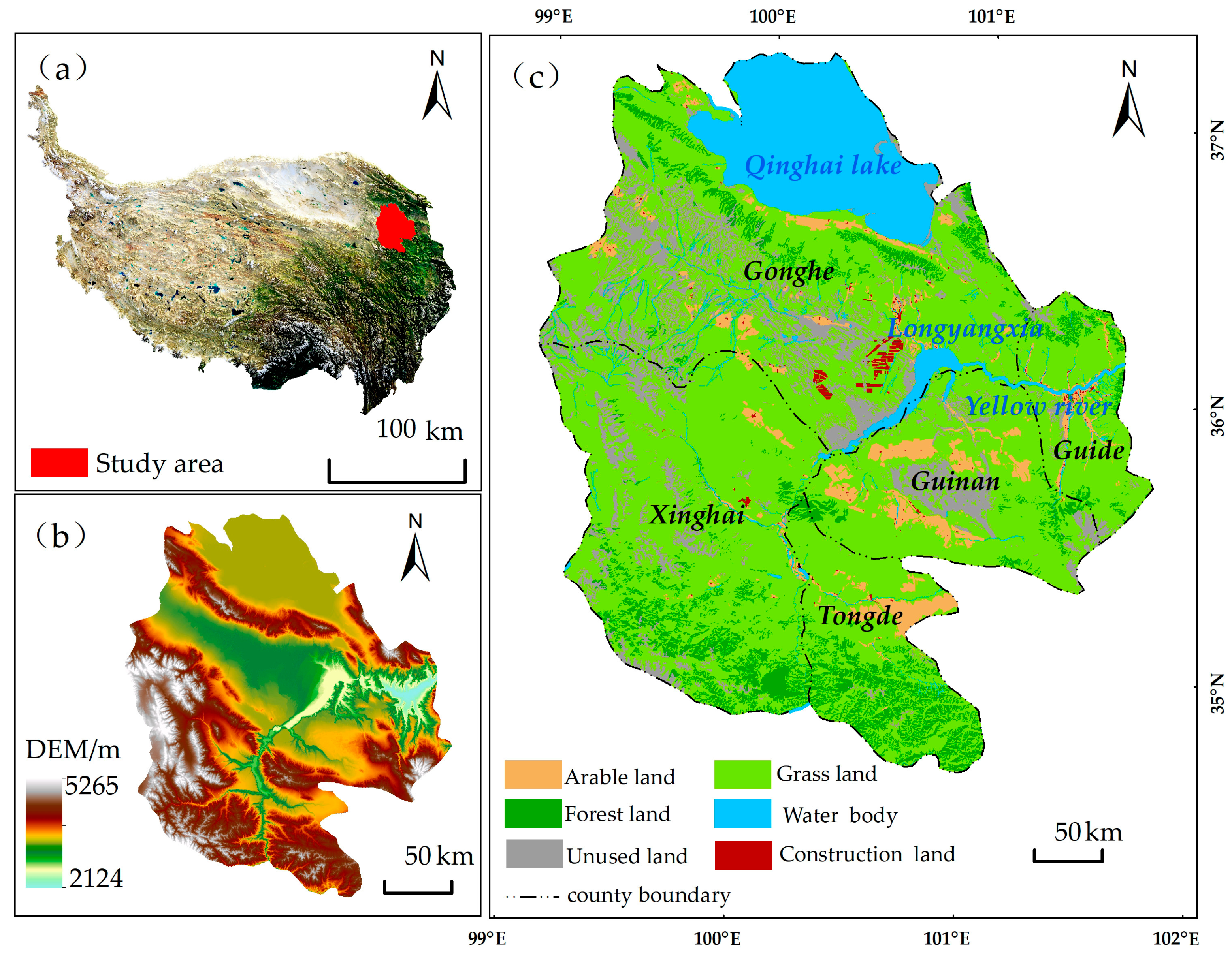
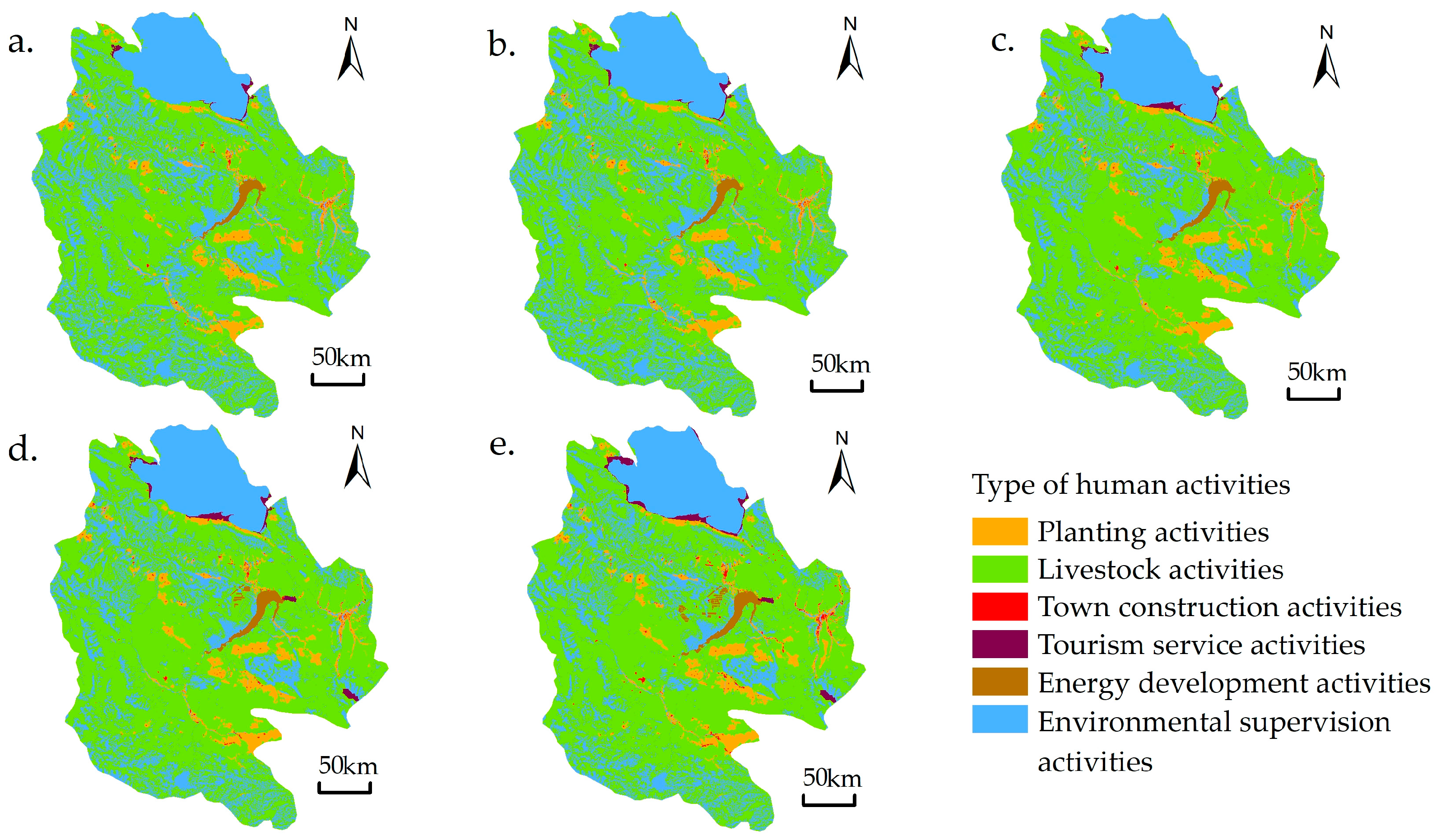
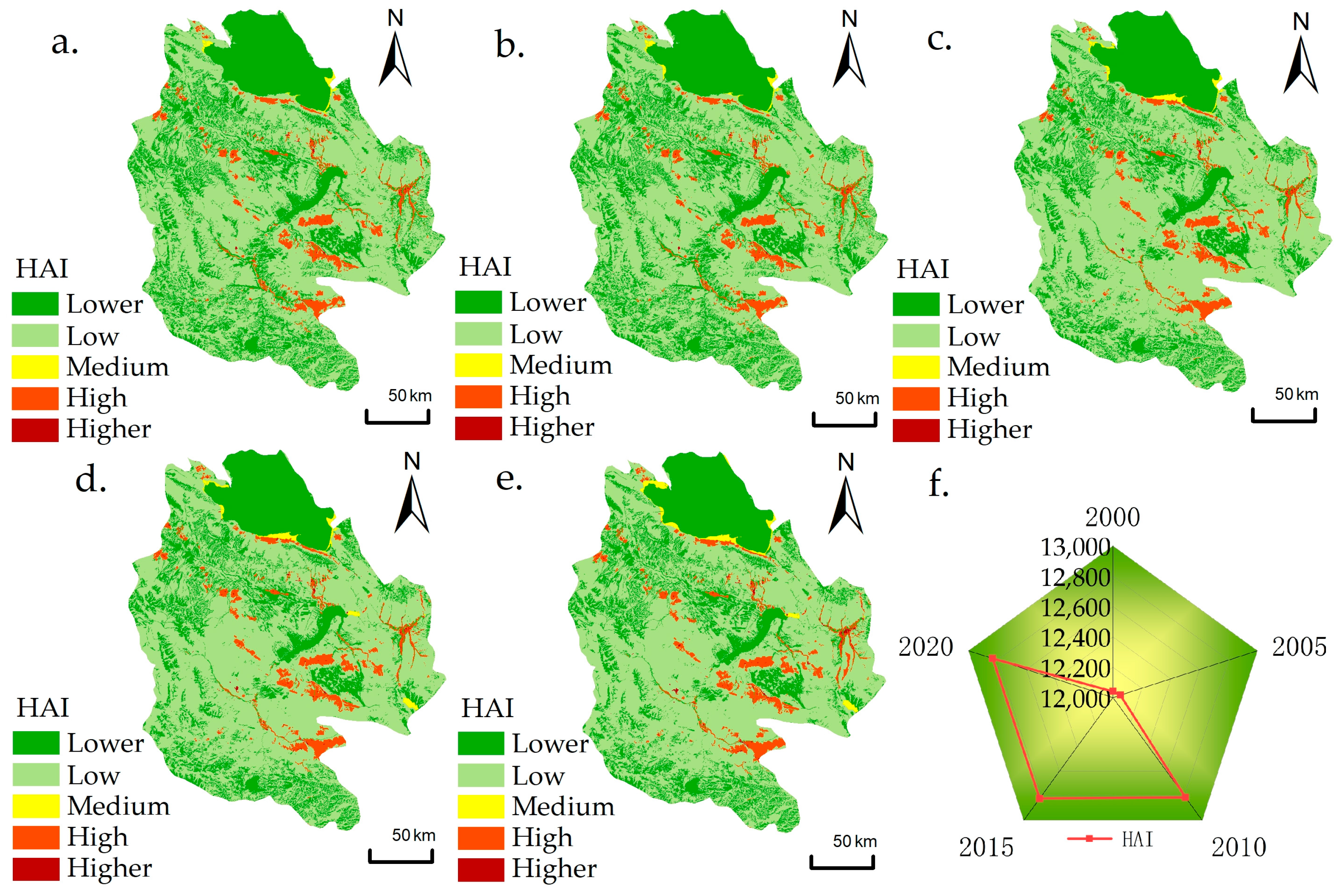



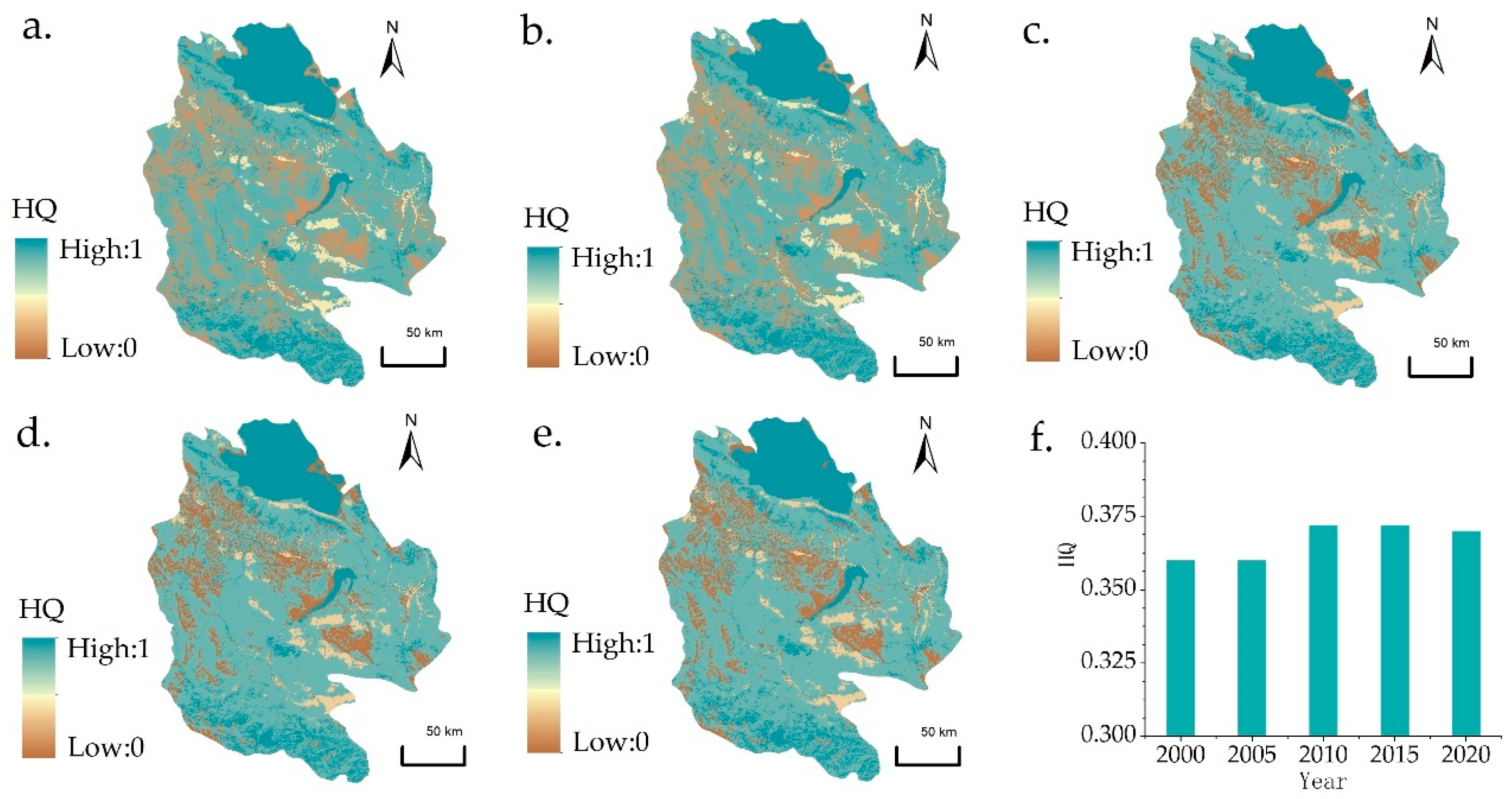
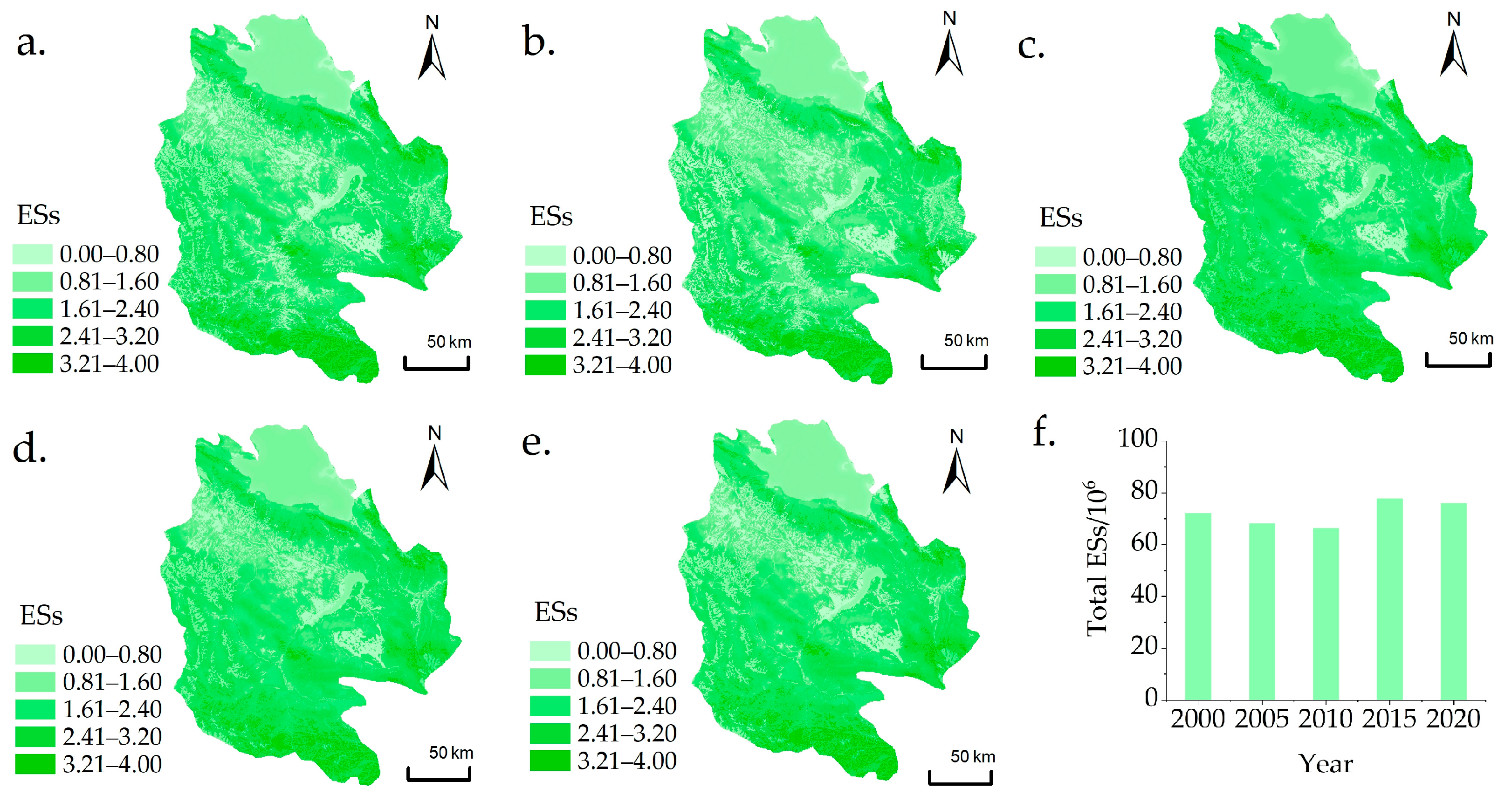
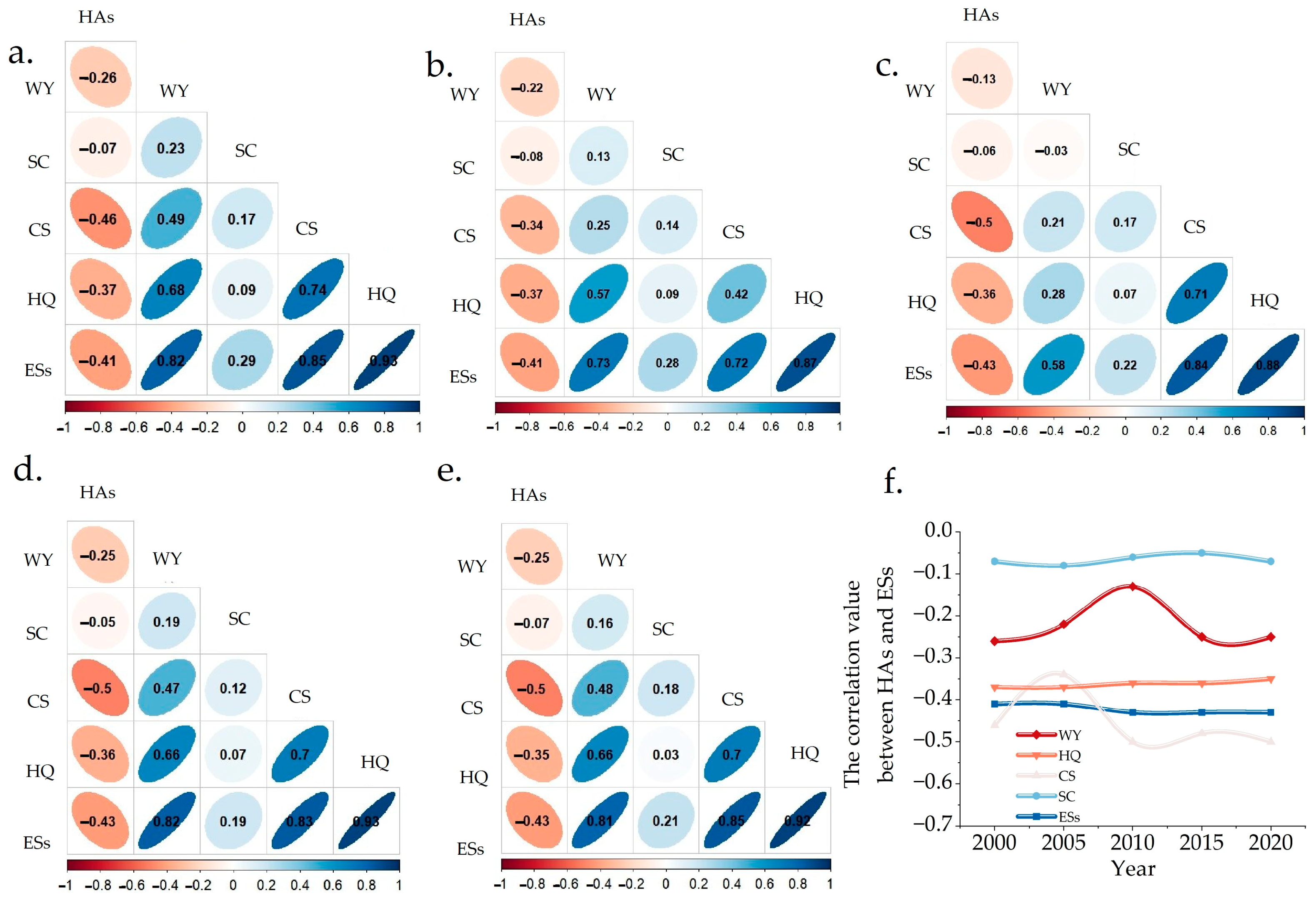

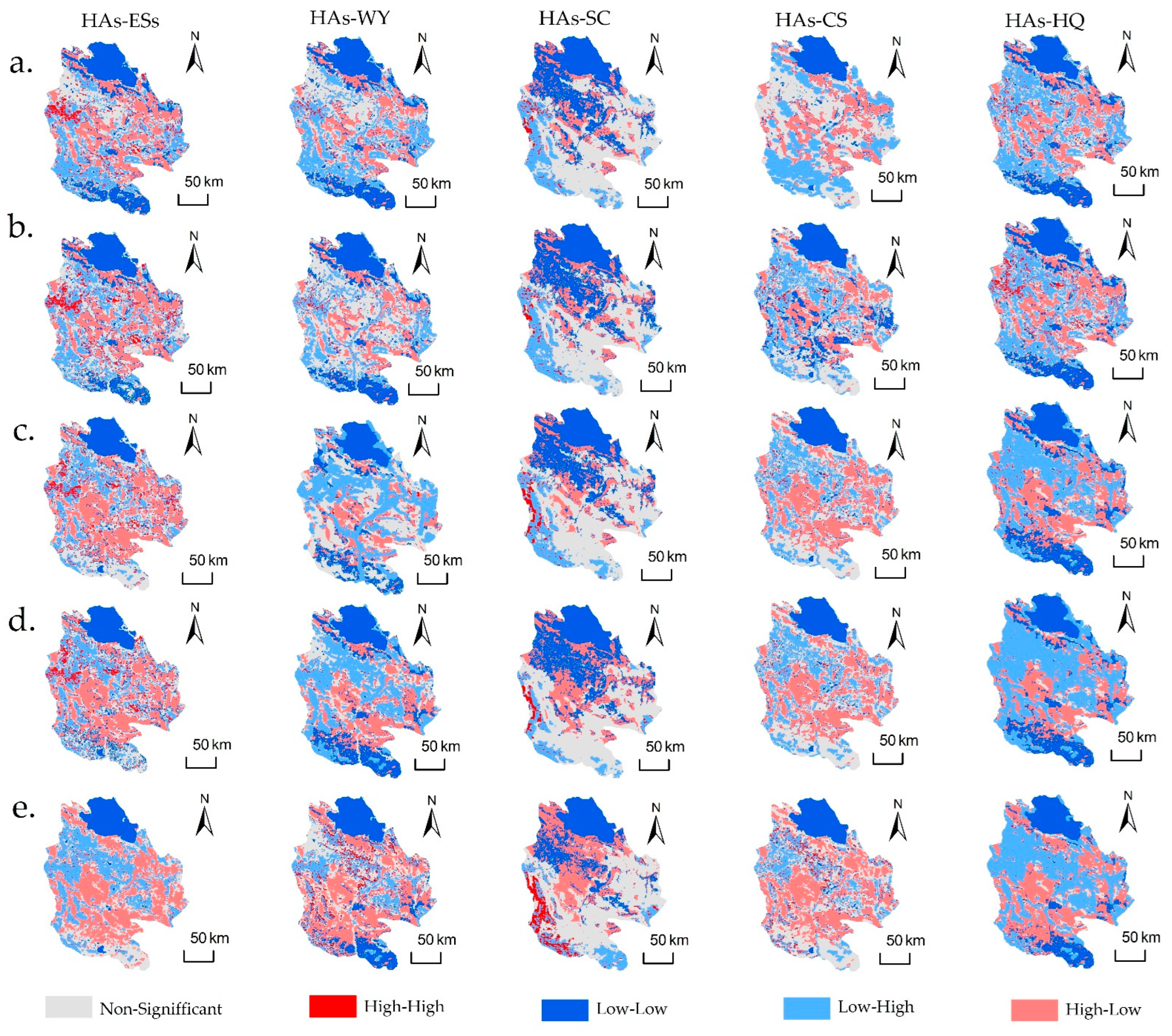
| Data Type | Data Name | Data Characteristics | Source of Data |
|---|---|---|---|
| Remote sensing image | Landsat TM imagery | Raster | Geospatial data cloud (http://www.gscloud.cn/ (accessed on 16 October 2024)) |
| Land use/cover | China land cover raster data | Raster | Data Center for Resources and Environmental Sciences, Chinese Academy of Sciences (http://www.resdc.cn/ (accessed on 16 October 2024)) |
| Meteorological data | China’s 1 km resolution annual precipitation data China’s 1 km resolution monthly potential evapotranspiration dataset | Raster | National Earth System Science Data Center (http://www.geodata.cn/ (accessed on 16 October 2024)) |
| Soil data | Spatial distribution data of world soil types | Raster | World Soil Database (https://www.fao.org/soils-portal/ (accessed on 16 October 2024)) |
| Topographic and geomorphologic data | Digital Elevation Model (DEM) | Raster | Geospatial spatial data cloud (http://www.gscloud.cn/ (accessed on 16 October 2024)) |
| Administrative boundaries | 2020 edition of administrative division map of national basic geographic information database | Shp | National fundamental geographic databases (https://www.webmap.cn/ (accessed on 16 October 2024)) |
| Socio-economic data | Hainan Tibetan Autonomous Prefecture Statistical Yearbook Hainan Tibetan Autonomous Prefecture Statistical Bulletin | TXT | Hainan Tibetan Autonomous Prefecture People’s Government (https://www.hainanzhou.gov.cn/ (accessed on 16 October 2024)) |
| Hainan Tibetan Autonomous Prefecture Statistical Bulletin |
| Land Use Type | Land Use Code | Vegetation Coefficient | Root Depth | Evapotranspiration Coefficient (Kc) |
|---|---|---|---|---|
| Arable land | 1 | 1 | 2100 | 0.7 |
| Forest Land | 2 | 1 | 5200 | 0.9 |
| Grassland | 3 | 1 | 2600 | 0.6 |
| Water body | 4 | 0 | −1 | 0.8 |
| Construction land | 5 | 0 | −1 | 1 |
| Unused land | 6 | 0 | −1 | 1 |
| Land Use Type | Arable Land | Forest Land | Grassland | Water Body | Construction Land | Unused Land |
|---|---|---|---|---|---|---|
| C Factor | 0.3 | 0.16 | 0.05 | 0 | 1 | 1 |
| P Factor | 0.3 | 0.04 | 0.1 | 0 | 0.01 | 1 |
| Land Use Type | C_Above | C_Below | C_Soil | C_Dead |
|---|---|---|---|---|
| Arable land | 5.44 | 2.57 | 123.83 | 1.24 |
| Forest Land | 37.36 | 15.60 | 300.70 | 3.05 |
| Grassland | 8.58 | 7.24 | 205.22 | 0.36 |
| Water body | 0.93 | 0.66 | 82.20 | 1.23 |
| Construction land | 3.29 | 2.11 | 78.20 | 0.00 |
| Unused land | 0.75 | 0.98 | 56.50 | 0.00 |
| Threat Factor | Maximum Impact Distance (km) | Weight | Spatial Decay Type |
|---|---|---|---|
| Arable land | 4 | 0.7 | Linear |
| Construction land | 7 | 0.7 | Exponential |
| Unused land | 6 | 0.5 | Linear |
| Land Use Type | Land Use Code | Suitability | Arable Land | Construction Land | Unused Land |
|---|---|---|---|---|---|
| Arable land | 1 | 0.3 | 0.1 | 0.6 | 0.3 |
| Forest Land | 2 | 1 | 0.4 | 0.7 | 0.5 |
| Grassland | 3 | 0.7 | 0.2 | 0.6 | 0.4 |
| Water body | 4 | 0.9 | 0.2 | 0.7 | 0.4 |
| Construction land | 5 | 0.1 | 0.1 | 0.1 | 0.2 |
| Unused land | 6 | 0.2 | 0.3 | 0.6 | 0.1 |
| Type of Human Activities | 2000 | 2005 | 2010 | 2015 | 2020 | 2000–2020 |
|---|---|---|---|---|---|---|
| Plantation activities | 1830.81 | 1854.78 | 2100.18 | 2094.65 | 2102.67 | 1996.62 |
| Livestock activities | 26,981.10 | 26,935.83 | 28,866.17 | 28,745.28 | 28,500.82 | 28,005.84 |
| Town construction activities | 85.82 | 86.72 | 89.48 | 99.56 | 134.53 | 99.22 |
| Tourism service activities | 98.49 | 123.76 | 199.51 | 286.85 | 389.87 | 219.7 |
| Energy development activities | 313.11 | 312.08 | 369.11 | 426.78 | 511.08 | 386.43 |
| Environmental supervision activities | 15,843.28 | 15,840.12 | 13,528.84 | 13,499.80 | 13,514.33 | 14,445.27 |
Disclaimer/Publisher’s Note: The statements, opinions and data contained in all publications are solely those of the individual author(s) and contributor(s) and not of MDPI and/or the editor(s). MDPI and/or the editor(s) disclaim responsibility for any injury to people or property resulting from any ideas, methods, instructions or products referred to in the content. |
© 2025 by the authors. Licensee MDPI, Basel, Switzerland. This article is an open access article distributed under the terms and conditions of the Creative Commons Attribution (CC BY) license (https://creativecommons.org/licenses/by/4.0/).
Share and Cite
Sun, A.; Zhang, H.; Xia, X.; Ma, X.; Wang, Y.; Chen, Q.; Fei, D.; Pan, Y. Response of Ecosystem Services to Human Activities in Gonghe Basin of the Qinghai–Tibetan Plateau. Land 2025, 14, 1350. https://doi.org/10.3390/land14071350
Sun A, Zhang H, Xia X, Ma X, Wang Y, Chen Q, Fei D, Pan Y. Response of Ecosystem Services to Human Activities in Gonghe Basin of the Qinghai–Tibetan Plateau. Land. 2025; 14(7):1350. https://doi.org/10.3390/land14071350
Chicago/Turabian StyleSun, Ailing, Haifeng Zhang, Xingsheng Xia, Xiaofan Ma, Yanqin Wang, Qiong Chen, Duqiu Fei, and Yaozhong Pan. 2025. "Response of Ecosystem Services to Human Activities in Gonghe Basin of the Qinghai–Tibetan Plateau" Land 14, no. 7: 1350. https://doi.org/10.3390/land14071350
APA StyleSun, A., Zhang, H., Xia, X., Ma, X., Wang, Y., Chen, Q., Fei, D., & Pan, Y. (2025). Response of Ecosystem Services to Human Activities in Gonghe Basin of the Qinghai–Tibetan Plateau. Land, 14(7), 1350. https://doi.org/10.3390/land14071350





